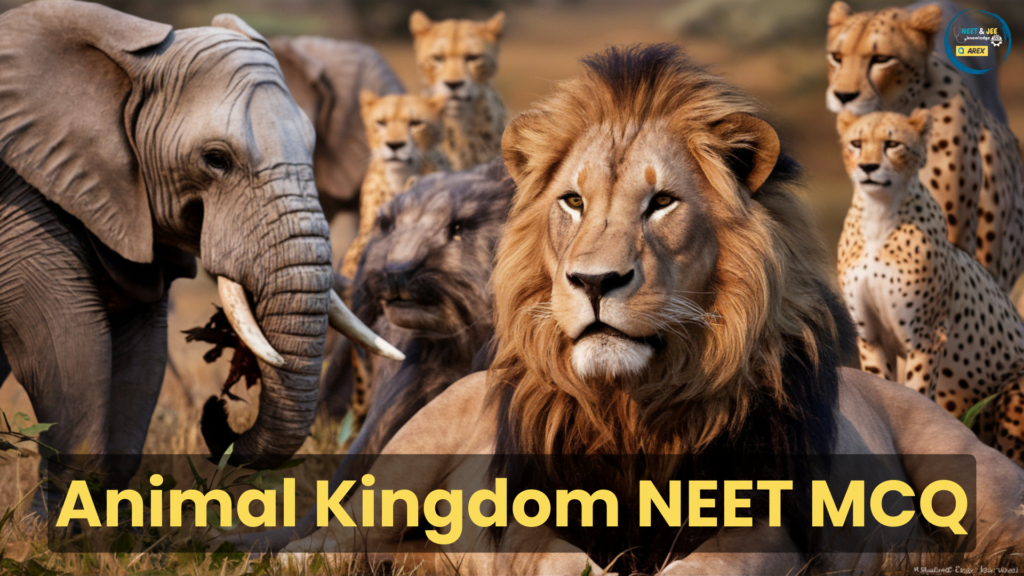
Animal Kingdom NEET MCQ
Animal Kingdom refers to one of the five kingdoms of Biological Classification. The Animal Kingdom is also known as Kingdom Animalia. It includes a huge range of multicellular, eukaryotic organisms. Animals are characterized by specialized cells that form tissues and organs and most undergo complex developmental stages from zygote to adult.
Major phyla include Porifera (sponges), Cnidaria (jellyfish), Platyhelminthes (flatworms), Nematoda (roundworms), Annelida (segmented worms), Arthropoda (insects, arachnids), Mollusca (snails, octopuses), Echinodermata (starfish) and Chordata (vertebrates). Animals body structure, Survival adaptation and reproduction strategies are further classified into different classes.
| NEET 2025 Exam Important Links | |
|---|---|
| NEET 2025 Updated Syllabus | NEET Eligibility Criteria 2025 |
| Biology Preparation | Chemistry NEET Preparation |
| NEET Preparation tips for 2025 | NEET Result 2024 |
Animal Kingdom NEET MCQ
In NEET, understanding the Animal Kingdom’s classification and features is important. Key concepts include the distinction between invertebrates and vertebrates, body symmetry (radial, bilateral) and the presence of coelom (body cavity). Knowledge of each phylum’s unique traits, such as the segmented body of annelids or the exoskeleton of arthropods, is important.
Moreover, studying various reproductive strategies, developmental stages and physiological adaptations across animal phyla helps in grasping their evolutionary relationships and ecological roles.
Animal Kingdom NEET MCQ with Answers


Tube-within-tube is a body plan in which digestive canal is present inside the body cavity have appears tube with in a tube. All animals from the phylum-Aschelminthes to Chordata have tube-within-tube body plan and may be either protostomous or deuterostomous.
Enhance your preparation with Arexiq’s Mock Test Series where we provide solutions to various MCQs like we provide in this post “Animal Kingdom MCQ for NEET”. Our expert teachers explain the concepts thoroughly, making it easy for you to understand. We offer many types of questions ensuring a clear grasp of concepts.
FAQs
Q1: What is the Animal Kingdom?
Answer: The Animal Kingdom, or Kingdom Animalia, consists of multicellular, eukaryotic organisms that are primarily heterotrophic and capable of movement at some stage of their life cycle. They exhibit specialized cells forming tissues and organs.
Q2: What are the major phyla in the Animal Kingdom?
Answer: Major phyla include Porifera (sponges), Cnidaria (jellyfish), Platyhelminthes (flatworms), Nematoda (roundworms), Annelida (segmented worms), Arthropoda (insects, arachnids), Mollusca (snails, octopuses), Echinodermata (starfish) and Chordata (vertebrates).
Q3: How are animals classified in the Animal Kingdom?
Answer: Animals are classified based on various criteria including body symmetry (radial or bilateral), the presence or absence of a coelom (body cavity), segmentation and developmental patterns (protostomes vs. deuterostomes).
Q4: What is the difference between invertebrates and vertebrates?
Answer: Invertebrates lack a vertebral column (backbone) and include phyla like Arthropoda and Mollusca. Vertebrates possess a vertebral column and belong to the phylum Chordata, which includes classes such as mammals, birds, reptiles, amphibians and fish.
Q5: What are some key features of the phylum Arthropoda?
Answer: Arthropods have a segmented body, an exoskeleton made of chitin, jointed appendages, and undergo molting. Examples include insects, arachnids (spiders) and crustaceans (crabs).
Q6: What is unique about the phylum Chordata?
Answer: Chordates have a notochord, a dorsal hollow nerve cord, pharyngeal slits and a post-anal tail at some stage of their development. This phylum includes vertebrates such as mammals, birds, reptiles, amphibians and fish.
Q7: Why is understanding the Animal Kingdom important for NEET?
Answer: Knowledge of the Animal Kingdom is important for NEET as it covers fundamental aspects of biology, including classification, anatomy, physiology and evolutionary relationships, all of which are essential for medical studies.


